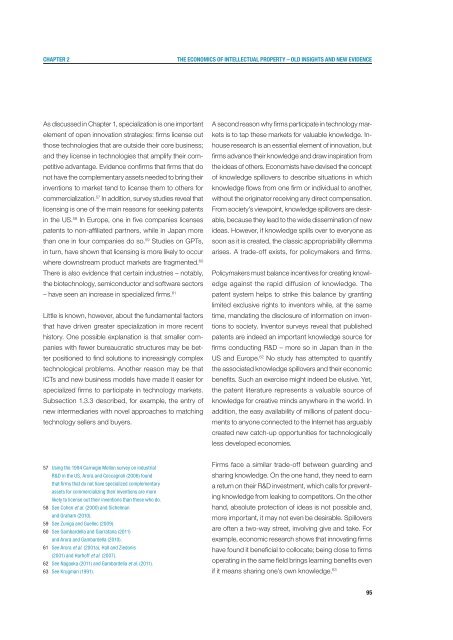World Intellectual Property Report 2011
World Intellectual Property Report 2011
World Intellectual Property Report 2011
Create successful ePaper yourself
Turn your PDF publications into a flip-book with our unique Google optimized e-Paper software.
Chapter 2 the eConomiCs of intelleCtual property – old insights and new evidenCe<br />
As discussed in Chapter 1, specialization is one important<br />
element of open innovation strategies: firms license out<br />
those technologies that are outside their core business;<br />
and they license in technologies that amplify their competitive<br />
advantage. Evidence confirms that firms that do<br />
not have the complementary assets needed to bring their<br />
inventions to market tend to license them to others for<br />
commercialization. 57 In addition, survey studies reveal that<br />
licensing is one of the main reasons for seeking patents<br />
in the US. 58 In Europe, one in five companies licenses<br />
patents to non-affiliated partners, while in Japan more<br />
than one in four companies do so. 59 Studies on GPTs,<br />
in turn, have shown that licensing is more likely to occur<br />
where downstream product markets are fragmented. 60<br />
There is also evidence that certain industries – notably,<br />
the biotechnology, semiconductor and software sectors<br />
– have seen an increase in specialized firms. 61<br />
Little is known, however, about the fundamental factors<br />
that have driven greater specialization in more recent<br />
history. One possible explanation is that smaller companies<br />
with fewer bureaucratic structures may be better<br />
positioned to find solutions to increasingly complex<br />
technological problems. Another reason may be that<br />
ICTs and new business models have made it easier for<br />
specialized firms to participate in technology markets.<br />
Subsection 1.3.3 described, for example, the entry of<br />
new intermediaries with novel approaches to matching<br />
technology sellers and buyers.<br />
57 Using the 1994 Carnegie Mellon survey on industrial<br />
R&D in the US, Arora and Ceccagnoli (2006) found<br />
that firms that do not have specialized complementary<br />
assets for commercializing their inventions are more<br />
likely to license out their inventions than those who do.<br />
58 See Cohen et al. (2000) and Sichelman<br />
and Graham (2010).<br />
59 See Zuniga and Guellec (2009).<br />
60 See Gambardella and Giarratana (<strong>2011</strong>)<br />
and Arora and Gambardella (2010).<br />
61 See Arora et al. (2001a), Hall and Ziedonis<br />
(2001) and Harhoff et al. (2007).<br />
62 See Nagaoka (<strong>2011</strong>) and Gambardella et al. (<strong>2011</strong>).<br />
63 See Krugman (1991).<br />
A second reason why firms participate in technology markets<br />
is to tap these markets for valuable knowledge. Inhouse<br />
research is an essential element of innovation, but<br />
firms advance their knowledge and draw inspiration from<br />
the ideas of others. Economists have devised the concept<br />
of knowledge spillovers to describe situations in which<br />
knowledge flows from one firm or individual to another,<br />
without the originator receiving any direct compensation.<br />
From society’s viewpoint, knowledge spillovers are desirable,<br />
because they lead to the wide dissemination of new<br />
ideas. However, if knowledge spills over to everyone as<br />
soon as it is created, the classic appropriability dilemma<br />
arises. A trade-off exists, for policymakers and firms.<br />
Policymakers must balance incentives for creating knowledge<br />
against the rapid diffusion of knowledge. The<br />
patent system helps to strike this balance by granting<br />
limited exclusive rights to inventors while, at the same<br />
time, mandating the disclosure of information on inventions<br />
to society. Inventor surveys reveal that published<br />
patents are indeed an important knowledge source for<br />
firms conducting R&D – more so in Japan than in the<br />
US and Europe. 62 No study has attempted to quantify<br />
the associated knowledge spillovers and their economic<br />
benefits. Such an exercise might indeed be elusive. Yet,<br />
the patent literature represents a valuable source of<br />
knowledge for creative minds anywhere in the world. In<br />
addition, the easy availability of millions of patent documents<br />
to anyone connected to the Internet has arguably<br />
created new catch-up opportunities for technologically<br />
less developed economies.<br />
Firms face a similar trade-off between guarding and<br />
sharing knowledge. On the one hand, they need to earn<br />
a return on their R&D investment, which calls for preventing<br />
knowledge from leaking to competitors. On the other<br />
hand, absolute protection of ideas is not possible and,<br />
more important, it may not even be desirable. Spillovers<br />
are often a two-way street, involving give and take. For<br />
example, economic research shows that innovating firms<br />
have found it beneficial to collocate; being close to firms<br />
operating in the same field brings learning benefits even<br />
if it means sharing one’s own knowledge. 63<br />
95

















